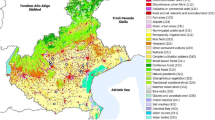Abstract
Harvester ants have long been known to exhibit interspecific seed preference and this preference has been thought to be associated with distance in a manner analogous with optimal foraging theory. However, little attention has been given to how intraspecific seed preference changes or how microhabitat (i.e. the composition of the terrain that the ants are moving through) impacts seed harvesting preference. We addressed these questions by conducting seed harvesting experiments in three different Ephedra viridis populations that contain harvester ants (Pogonomyrmex occidentalis) by using only E. viridis seeds and conducting trials over multiple distances and varying degrees of microhabitat cover. We found that increased microhabitat cover and increased seed mass decrease the likelihood of E. viridis seeds being harvested much more dramatically than distance. However, we found no effect of distance or microhabitat cover on which E. viridis seeds were harvested. We conclude that harvester ant E. viridis seed preference is distance and microhabitat independent. However, increases in microhabitat cover negatively impacts the likelihood of P. occidentalis harvesting E. viridis seeds of any size. Our findings suggest that harvester ant foraging behavior is influenced by structure of the microhabitat more than by distance. This provides a new context on how harvester ant foraging behavior and effectiveness should be considered.






Similar content being viewed by others
References
Akaike H (1974) A new look at the statistical model identification. IEEE Trans Autom Control 19:716–723
Arnan X, Retana J, Rodrigo A, Cerdá X (2010) Foraging behaviour of harvesting ants determines seed removal and dispersal. Insect Soc 57:421–430. doi:10.1007/s00040-010-0100-7
Bates D, Maechler M, Bolker B et al (2015) lme4: Linear Mixed-Effects Models using “Eigen” and S4. https://cran.r-project.org/web/packages/lme4/index.html
Brown JH, Reichman OJ, Davidson DW (1979) Granivory in desert ecosystems. Annu Rev Ecol Syst:201–227
Charnov EL (1976) Optimal foraging, the marginal value theorem. Theor Popul Biol 9:129–136
Crist TO, MacMahon JA (1991) Individual foraging components of harvester ants: movement patterns and seed patch fidelity. Insect Soc 38:379–396
Crist TO, MacMahon JA (1992) Harvester ant foraging and shrub-steppe seeds: interactions of seed resources and seed use. Ecology:1768–1779
Crist TO, Wiens JA (1994) Scale effects of vegetation on forager movement and seed harvesting by ants. Oikos:37–46
Davidson DW (1977) Species diversity and community organization in desert seed-eating ants. Ecology:712–724
Detrain C, Tasse O (2000) Seed drops and caches by the harvester ant Messor barbarus: do they contribute to seed dispersal in Mediterranean grasslands? Naturwissenschaften 87:373–376. doi:10.1007/s001140050744
Fewell JH (1988) Energetic and time costs of foraging in harvester ants, Pogonomyrmex occidentalis. Behav Ecol Sociobiol 22:401–408
Holder K, Polis GA (1987) Optimal and central-place foraging theory applied to a desert harvester ant, Pogonomyrmex californicus. Oecologia 72:440–448
Kelrick MI, MacMahon JA, Parmenter RR, Sisson DV (1986) Native seed preferences of shrub-steppe rodents, birds and ants: the relationships of seed attributes and seed use. Oecologia 68:327–337
Knoch TR, Faeth SH, Arnott DL (1993) Endophytic fungi alter foraging and dispersal by desert seed-harvesting ants. Oecologia 95:470–473
MacMahon JA, Mull JF, Crist TO (2000) Harvester ants (Pogonomyrmex spp.): their community and ecosystem influences. Annu Rev Ecol Syst:265–291
Ostoja SM, Schupp EW, Klinger R (2013) Seed harvesting by a generalist consumer is context-dependent: interactive effects across multiple spatial scales. Oikos 122:563–574
R Core Team (2016) R: A language and environment for statistical computing. R Foundation for Statistical Computing, Vienna
Retana J, Xavier Picó F, Rodrigo A (2004) Dual role of harvesting ants as seed predators and dispersers of a non-myrmechorous Mediterranean perennial herb. Oikos 105:377–385. doi:10.1111/j.0030-1299.2004.12854.x
Rodgerson L (1998) Mechanical defense in seeds adapted for ant dispersal. Ecology 79:1669–1677
RStudio (2015) RStudio: Integrated development environment for R. Boston, MA
Schoener TW (1971) Theory of feeding strategies. Annu Rev Ecol Syst:369–404
Wickham H (2009) ggplot2: elegant graphics for data analysis. Springer, New York
Acknowledgments
We would like to thank the University of Nevada, Reno for providing us with the opportunity to conduct this research. We would like to thank all the undergraduate lab assistants who helped weigh and measure all of the seeds in this experiment. We would also like to thank the reviewers who provided valuable feedback in improving the quality of this manuscript. Lastly, we would like to thank all of the individuals at the University of Nevada, Reno who provided valuable feedback during the development of this project. This work was supported by the National Science Foundation GK-12 Program, Grant DGE No. 1045584 [AH]. Any opinions, findings, and conclusions or recommendations expressed in this material are those of the author(s) and do not necessarily reflect the views of the National Science Foundation; This was supported by the University of Nevada, Reno Ecology, Evolution, and Conservation Biology department summer research grant [AH].
Author information
Authors and Affiliations
Corresponding author
Rights and permissions
About this article
Cite this article
Hickey, A., Hollander, J. & Peacock, M. Assessing Microhabitat Cover and Distance Effects on Harvester Ant Intraspecific Seed Preference. J Insect Behav 29, 535–547 (2016). https://doi.org/10.1007/s10905-016-9580-2
Revised:
Accepted:
Published:
Issue Date:
DOI: https://doi.org/10.1007/s10905-016-9580-2




